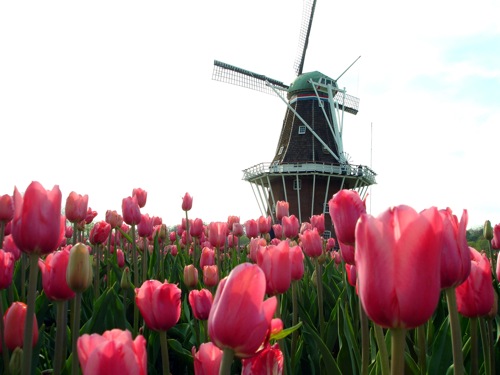
Courtesy Holland CVB
In the heartland of America, some towns have a distinctly European flavor.
European immigrants have settled all over the United States, and their cultures quickly blended into the melting pot of greater Americana. But in some places throughout the Midwest, vestiges of those distinct European nationalities remain, giving those destinations distinctive ambiance and appeal.
For tour groups, those destinations afford some exciting opportunities. Groups can experience authentic food, music, art and architecture from international destinations without having to travel too far from home.
There’s an unmistakable German influence in Northern Indiana’s Amish Country, and New Ulm, Minnesota, has been designated the most German city in the United States. Holland, Michigan, has some of the same windmills and tulips that make the Netherlands famous. Lindsborg, Kansas, preserves the culture of its Swedish immigrant founders, and New Glarus, Wisconsin, gives visitors a taste of Switzerland.
Holland
Michigan
If someone tells you that they’re headed to Holland, there’s a good chance that they’re referring to the Michigan town that has built a reputation on its Dutch culture and traditions. Make a trip there yourself, and you’ll find evidence of Dutch influence all around.
“The biggest attraction is DeZwaan Windmill,” said Sally Laukitis, executive director of the
Holland Convention and Visitors Bureau. “It’s a 250-year-old windmill, t he last one ever to leave the Netherlands. It’s situated in Windmill Island Gardens, where there are beautiful gardens, a greenhouse and lots of Dutch architecture.”
Locals still use the windmill to grind Michigan wheat into flour. Groups can see the mill in action during a tour of its top five floors.
Nelis Dutch Village, another popular group attraction, is a re-creation of a Dutch community from 100 years ago. It has Dutch dancers, a wooden shoe factory and numerous Dutch craft demonstrations. Groups there can have a hands-on experience making “bankets” — traditional Dutch almond pastries.
Groups also enjoy visiting the Veldheer Tulip Gardens and the DeKlomp Wooden Shoe and Delft Factory, where artisans create the popular blue-and-white tableware widely associated with the Netherlands.
“It’s the only place in the country where delftware is made,” Laukitis said. “People can have a demonstration, and see workers hand painting and firing the delftware. They also make wooden shoes there on machines that are imported from the Netherlands.”
Many groups plan visits to Holland to coincide with the Tulip Time Festival in early May. This famous festival features Dutch food, crafts, music and dance demonstrations set in a city filled with hundreds of thousands of blooming tulips.
www.holland.org
Lindsborg
Kansas
In central Kansas, the small town of Lindsborg got its start in 1869 when a group of Swedish immigrants settled it and numerous other farming colonies in the area. About 125 Swedish immigrants arrived to farm in the valley, and Lindsborg is the last of the colonies that still observes many Swedish traditions such as the “sika.”
“Sika is a little something nice to do,” said Carla Wilson, director of the Lindsborg Convention and Visitors Bureau. “You stop and have a little bit of coffee and treats a couple of times a day. That’s always been observed — at 10 o’clock and 2 o’clock, you stop and have coffee and visit with people. It’s part of the farmers’ and merchants’ lives.”
There are also other ways to experience Lindsborg’s Swedish heritage, such as stopping at the 1868 Dugout to see the kind of structures that the area’s first settlers lived in. A number of special events throughout the year highlight Swedish culture. Every two years, the town holds Svensk Hyllningfest, a “Swedish honoring festival” that draws thousands of visitors for traditional food, music and dance.
Whenever they visit, groups will enjoy some of the artwork that has become a central part of the community.
“The Swedish settlers wanted music and art to be available to everyone,” Wilson said. “So we have a public art tour that showcases over 50 pieces within a two-block area downtown. We also have a herd of 31 Dala horses downtown. The Dala horse is the national folk symbol of Sweden, and each one of the horses is painted with a different artist’s interpretation of Lindsborg’s history.”










